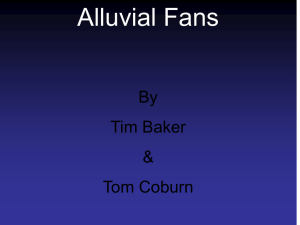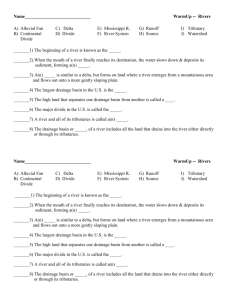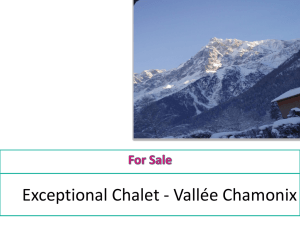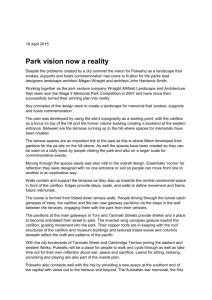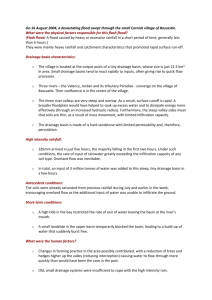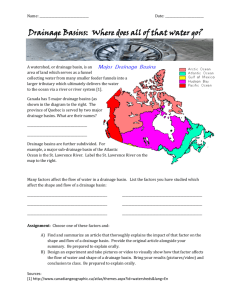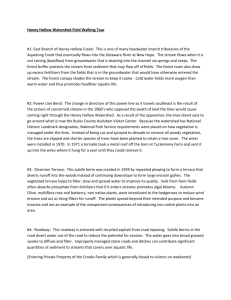AuthorsResponsetoReviews
advertisement
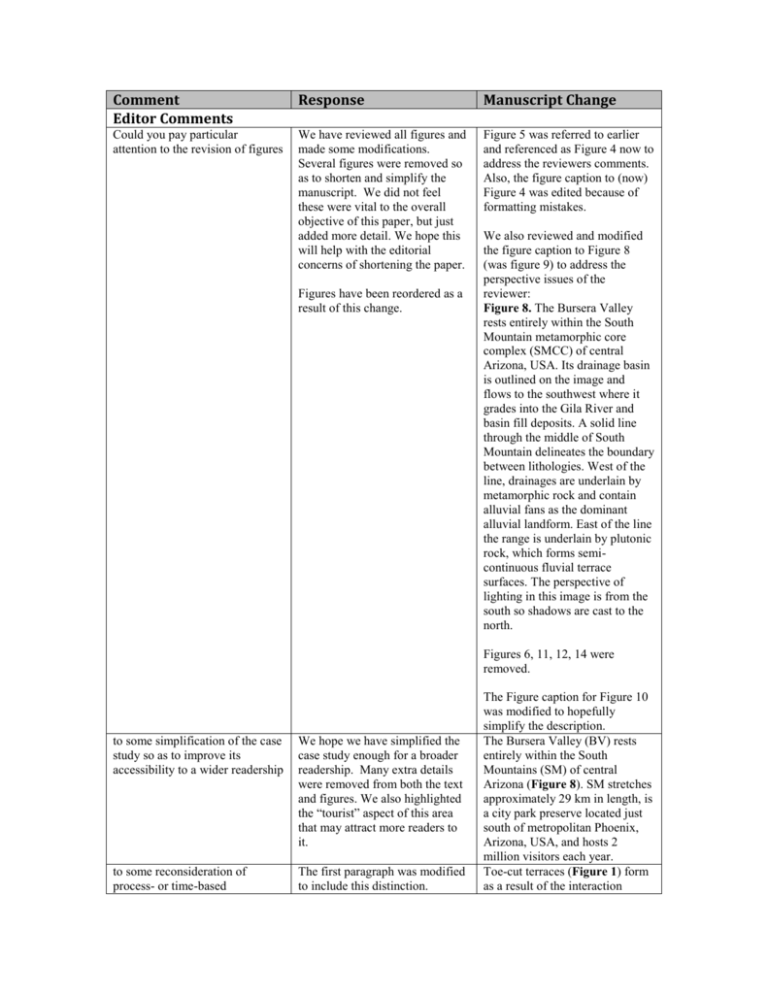
Comment Editor Comments Response Manuscript Change Could you pay particular attention to the revision of figures We have reviewed all figures and made some modifications. Several figures were removed so as to shorten and simplify the manuscript. We did not feel these were vital to the overall objective of this paper, but just added more detail. We hope this will help with the editorial concerns of shortening the paper. Figure 5 was referred to earlier and referenced as Figure 4 now to address the reviewers comments. Also, the figure caption to (now) Figure 4 was edited because of formatting mistakes. Figures have been reordered as a result of this change. We also reviewed and modified the figure caption to Figure 8 (was figure 9) to address the perspective issues of the reviewer: Figure 8. The Bursera Valley rests entirely within the South Mountain metamorphic core complex (SMCC) of central Arizona, USA. Its drainage basin is outlined on the image and flows to the southwest where it grades into the Gila River and basin fill deposits. A solid line through the middle of South Mountain delineates the boundary between lithologies. West of the line, drainages are underlain by metamorphic rock and contain alluvial fans as the dominant alluvial landform. East of the line the range is underlain by plutonic rock, which forms semicontinuous fluvial terrace surfaces. The perspective of lighting in this image is from the south so shadows are cast to the north. Figures 6, 11, 12, 14 were removed. to some simplification of the case study so as to improve its accessibility to a wider readership We hope we have simplified the case study enough for a broader readership. Many extra details were removed from both the text and figures. We also highlighted the “tourist” aspect of this area that may attract more readers to it. to some reconsideration of process- or time-based The first paragraph was modified to include this distinction. The Figure caption for Figure 10 was modified to hopefully simplify the description. The Bursera Valley (BV) rests entirely within the South Mountains (SM) of central Arizona (Figure 8). SM stretches approximately 29 km in length, is a city park preserve located just south of metropolitan Phoenix, Arizona, USA, and hosts 2 million visitors each year. Toe-cut terraces (Figure 1) form as a result of the interaction between a basin’s trunk stream and alluvial fans that originate from tributary drainages. They often form when a drainage basin’s trunk stream laterally migrates eroding the distal portion of an alluvial fan. This process is referred to as ‘toecutting’ (Figure 2; Leeder and Mack, 2001). The resulting landscape reflection of this process is the abandonment of the alluvial fan surface above the modern floodplain (Figure 3). Toe-cut terraces can also develop when vertical incision of the trunk stream lowers the local base-level of the tributary fan flowing into it, thus abandoning the former alluvial fan surface at a higher level (e.g. Figure 4; Colombo, 2005; Colombo et al., 2000). These two mechanisms are the focus of toe-cut terrace formation as they are modern processes acting at the surface. It is possible that exhumed toe-cut terraces may be present when deep vertical incision exposes formerly buried fan deposits and truncates them, however, the focus of this manuscript is on processes and deposits interacting at the Earth’s surface. As highlighted in the previous literature, toe-cut terraces are important features because of their broader implications for stratigraphic basin analysis, groundwater studies (Leeder and Mack, 2001) and landscape evolution, especially in arid environments (Larson, 2013). definitional criteria as noted The simplification of the case study - with some shortening - is an editorial concern which I have identified, not a comment on scientific quality We have attempted to simplify and shorten this section considerably. Shortening was primarily achieved through removal of wording and figures that added detail but was not essential to the overall point of the manuscript. Simplification proved more difficult. We felt that simplifying this case study too much would Very thorough editing and “cutting” took place within the Case Study section. We attempted to remove confusing or unnecessary discussion as it relates to the larger point of this manuscript. We believe these substantial edits will be clearly noticeable. We also removed several figures as they were not necessary in this context as well. result in an inappropriate representation of the difficulty in interpreting, and thus the need for the definition, of these landforms. This is the purpose of this paper. We did, however, try to make the text more clear and concise. Please see this section in the manuscript to note changes. They are far too long to put in this table. Reviewer #1 Comments This paper attempts to interpret terrace origins in a relatively small Arizona drainage basin. The discussion of the terrace types will likely be the most useful part of this paper. The application of the discriminating criteria to the Arizona basin, while probably necessary for the presentation, seems very complex, and may not be read in detail by most of the readership. My first problem with the paper began with the inclusion of a second cause for toe-cut terrace formation (lines 53-56). I didn’t understand from the text what was being described until I looked at Figure 5a sometime later. This second cause for toecut terraces needs to be added to a redrawn Figure 1, or the reader needs to be referred to Figure 5a when that cause is first described. Another problem (particular to my own research) is featured in lines 127 ff. At the location described there are two sloping terraces separated by a distinct 23 m scarp where a late Pleistocene alluvial fan built into the basin atop thick lake clays, forming an erosion-resistant layer atop the clays. The lower terrace is a sloping structural terrace caused by very heavy cementation of the underlying fan. The scarp described that separates the two sloping terraces formed when a major base-level drop led to deep erosion of the We agree that the most important part of this paper is the discussion/literature review on terrace genesis and form. However, we also believe the definition of this proposed form is equally useful. The complexity of the Arizona basin is complex, but necessary to show the difficulty in distinguishing these forms. Complexity in geomorphology is the norm in most studies. We agree that for some not familiar with this landform, this could be confusing. We have added some further clarification and referenced figure 5a. Figure 1 is not meant to show the mechanisms of formation, but a simple depiction of the complicated relationships of terrace landforms one may observe in the field. The first paragraph describing formation process and definition was modified to explain exhumed Toe-cut terraces and draw a distinction between past and present processes. Toe-cut terraces can also develop when vertical incision of a stream lowers the local base-level of the tributary fan flowing into it, thus abandoning the former alluvial fan surface at a higher level (e.g. Figure 4; Colombo, 2005; Colombo et al., 2000). Toe-cut terraces (Figure 1) form as a result of the interaction between a basin’s trunk stream and alluvial fans that originate from tributary drainages. They often form when a drainage basin’s trunk stream laterally migrates eroding the distal portion of an alluvial fan. This process is referred to as ‘toecutting’ (Figure 2; Leeder and Mack, 2001). The resulting landscape reflection of this process is the abandonment of the alluvial fan surface above the modern floodplain (Figure 3). Toe-cut terraces can also develop basin, exhuming the heavily cemented fan, and producing the scarp solely by erosion of the unprotected clays off of the lower, cemented surface. By the criteria of this paper, both terraces could be toe-cut terraces because both were caused by the trunk stream experiencing a major base level drop, combined with the fact that both coarse deposits originated as alluvial fans. My concern is that the lower structural terrace hasn’t been at the surface for more than 190 thousand years, and did not originate by any post-190 ka fanrelated process, and so I must question whether the authors really intend to describe the lower terrace as a toe-cut terrace. If it is, then this may mean that every former alluvial fan surface (with or without cemented horizons) that is exhumed in a dissected basin as a result of a base level drop is a toe-cut terrace. Because this paper’s present definition is: “Toe-cut terraces form as a result of the interaction between a basin’s trunk stream and alluvial fans that originate from tributary drainages” (lines 48-49), the surfaces the authors have describe in line 127ff would be toe-cut terraces. However, I would like them to reconsider carefully whether there should be any other process-based or time-based limitations on the definition that might exclude exhumed landforms and exhumed cemented fanglomerate horizons. On line 246 the authors describe a drainage basin incising headward and laterally across a landscape. I inferred that they might be excluding knickpoint incision here because it is described separately in the following paragraph. If line 246 is indeed describing knickpoint incision, then that needs to be explicitly said. If, on the other hand, they when vertical incision of the trunk stream lowers the local base-level of the tributary fan flowing into it, thus abandoning the former alluvial fan surface at a higher level (e.g. Figure 4; Colombo, 2005; Colombo et al., 2000). These two mechanisms are the focus of toe-cut terrace formation as they are modern processes acting at the surface. It is possible that exhumed toe-cut terraces may be present when deep vertical incision exposes formerly buried fan deposits and truncates them, however, the focus of this manuscript is on processes and deposits interacting at the Earth’s surface. As highlighted in the previous literature, toe-cut terraces are important features because of their broader implications for stratigraphic basin analysis, groundwater studies (Leeder and Mack, 2001) and landscape evolution, especially in arid environments (Larson, 2013). This paragraph was modified to address this confusion. Lithologic variations in drainage basins can also affect incision (Colombo et al., 2000; Ritter et al., 2002). As a drainage network evolves, it often incises headward and laterally across the landscape (i.e.knickpoint migration or interfluve denundation). This may result in changes through time in the materials entering from a stream are intending to describe the expansion of a drainage basin at the expense of another (e.g., a shifting interfluve), then that needs to be stated clearly (since that is a very slow process in the softest of materials). and its tributaries. For example, changes that result in the production of larger or smaller clasts can lead to aggradation or incision, assuming discharge rates are static. Changes in particle size can also impact the autogenic processes within a drainage network, where streams originating in mountains have a steeper gradient and higher elevation than neighboring tributaries originating over less resistant lithologies in the piedmont. This can lead to drainage capture by the lower elevation/gradient piedmont stream, which, in turn, can cause aggradation followed by incision as the capturing stream adjusts its longitudinal profile to variations in sediment input from upstream (Ritter, 1972). Line 332: no criterion should be specific to a given region. This appears to be an inadvertent mistake in how the paragraph is worded. The regional description was removed. Line 391: What does “downstream convergence” refer to specifically? Does it refer to a convergence of terrace treads? Clarify. Yes, it does refer to terrace treads. We have modified this sentence to be more clear. Line 592: “erodes the fan toe.” This was changed. Thank you! Lines 603-04: “but in reality originated as toe-cut terraces.” This was also changed. Thank you, again! At first Figure 9 was completely confusing to me. It appeared that the Bursera Valley boundaries are We have modified the figure caption to Figure 9. Where debris-flow processes dominate alluvial fan aggradation, the morphology of a fan surface can differ substantially from that of fluvial terraces derived from the drainage basin’s trunk stream. The one caveat to be aware of when using this criterion is that tectonic uplift of the tributary valley will also produce downstream convergence of terrace treads (e.g. Pewe, 1978); however, if tectonic activity can be ruled out, then convergence would indicate that the abandoned alluvial surface is likely a toe-cut terrace. Alluvial fans commonly feature scarps at their distal end produced when a stream erodes the fan toe. Employment of these criteria in the Bursera Valley, central Arizona, USA, illustrates their potential to correctly identify landforms that look very much like a fluvial terrace, but in reality originated as toe-cut terraces. Figure 8. The Bursera Valley rests entirely within the South Mountain metamorphic core in stream channels. When I turned the image upside down, I realized it might because shadows should always point to the viewer to avoid perceived topographic reversals. If the image isn’t reversed, this effect should be pointed out in the caption. It might also help if the Gila River is labeled in the lower left corner if, in fact, it is there. complex (SMCC) of central Arizona, USA. Its drainage basin is outlined on the image and flows to the southwest where it grades into the Gila River and basin fill deposits. A solid line through the middle of South Mountain delineates the boundary between lithologies. West of the line, drainages are underlain by metamorphic rock and contain alluvial fans as the dominant alluvial landform. East of the line the range is underlain by plutonic rock, which forms semicontinuous fluvial terrace surfaces. The perspective of lighting in this image is from the south so shadows are cast to the north.
